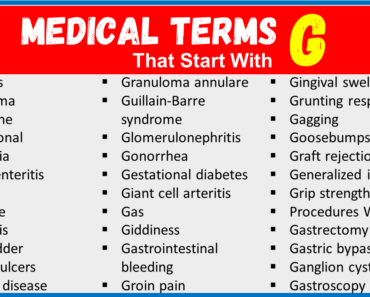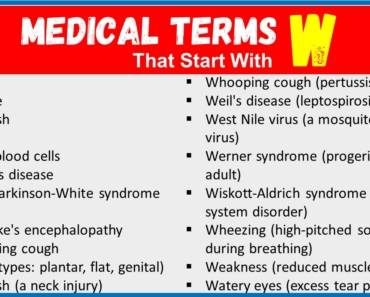In the vast realm of medicine, terminologies and jargons are abundant. Each letter of the alphabet is associated with a multitude of terms, be it conditions, procedures, or medications. The letter F is no exception. From a multitude of diseases to various drugs, the medical field has numerous terms starting with this sixth letter of the alphabet. Below, we will present a collection of such terms that are often heard in clinics, hospitals, and research laboratories.
Medical Terms That Start With F
Here is the list of the most popular words that start with the letter F:
- Fever
- Fracture
- Fibromyalgia
- Folic acid
- Fetus
- Fibrillation
- Fungus
- Fistula
- Fibrosis
- Fascia
Diseases and Conditions With F
- Fibromyalgia
- Fibrocystic breast condition
- Folliculitis
- Fatty liver disease
- Flat feet
- Frostbite
- Foot drop
- Folic acid deficiency
- Frontotemporal dementia
- Fibroadenoma
- Fasciitis
- Fibroids
- Furunculosis
- Functional dyspepsia
- Fanconi anemia
Symptoms With F
- Fatigue
- Fever
- Flushes
- Fainting
- Frequent urination
- Foot pain
- Facial swelling
- Finger numbness
- Floaters (in eyes)
- Flatulence
- Foul-smelling stool
- Fuzzy vision
- Foot cramps
- Facial redness
- Feeling of fullness
Procedures With F
- Fecal transplant
- Facelift
- Fistulogram
- Fine needle aspiration
- Femoral artery bypass
- Flexible sigmoidoscopy
- Femoral popliteal bypass
- Fundoplication
- Fluoroscopy
- Frenectomy
- FESS (Functional Endoscopic Sinus Surgery)
- Fasciotomy
- Fecal occult blood test
- Fracture repair
- Fistula repair
Medications With F
- Fluoxetine
- Furosemide
- Famotidine
- Fenofibrate
- Folic acid
- Fluconazole
- Felodipine
- Fluticasone
- Fexofenadine
- Flurazepam
- Finasteride
- Febuxostat
- Famciclovir
- Fluvoxamine
- Fulvestrant
Imaging and Tests With F
- Functional MRI (fMRI)
- Fluoroscopy
- Fasting blood sugar test
- Fecal occult blood test
- FSH (Follicle-stimulating hormone) test
- Flow cytometry
- Full body scan
- Flexible sigmoidoscopy
- Fine needle aspiration biopsy
- FEV1 (Forced expiratory volume) test
- Fibrinogen test
- Fungal culture
- Fluorescent antibody test
- Fundus photography
- Forced vital capacity (FVC) test
Vaccination and Immunology With F
- Flu vaccine
- Filariasis vaccine
- Formalin-killed vaccine
- Fungal antigen test
- Fractional-dose vaccination
- FluMist (intranasal flu vaccine)
- Fluzone
- Full antigen vaccination
- Favipiravir (antiviral)
- Fractionated immunoglobulin
- F(ab’)2 fragment
- Fluorescent antinuclear antibody test
- Fowl cholera vaccine
- Feline panleukopenia virus vaccine
- Fractional inactivated polio vaccine
Drugs With F
- Fentanyl
- Finasteride
- Famotidine
- Fluconazole
- Folic acid
- Fluoxetine
- Fluticasone
- Furosemide
- Fexofenadine
- Felodipine
- Febuxostat
- Flucytosine
- Floxuridine
- Fosfomycin
- Fenoprofen
A to Z Medical Glossary
A – B – C – D – E – F – G – H – I – J – K – L – M – N – O – P – Q – R – S – T – U – V – W – X – Y – Z
Medical Words With F & Their Meanings
- Fascia – A band of connective tissue beneath the skin.
- Fasciotomy – A surgical procedure to relieve tension or pressure.
- Fasciitis – Inflammation of the fascia.
- Fasting Blood Sugar (FBS) – A test to measure glucose levels after fasting.
- Fatigue – A feeling of weariness, tiredness, or lack of energy.
- Fecal – Relating to feces.
- Fecal Impaction – A large, hard mass of stool that gets stuck in the digestive tract.
- Femur – Thigh bone, the longest bone in the body.
- Fibrillation – Rapid, uncontrolled heartbeat.
- Fibrin – A protein involved in blood clotting.
- Fibroma – A benign tumor composed of fibrous tissue.
- Fibrosis – Thickening and scarring of connective tissue.
- Fibula – The smaller of the two bones in the lower leg.
- Fissure – A small tear or cut in tissue.
- Fistula – An abnormal connection between two body parts.
- Fluoroscopy – An imaging technique using X-rays to visualize body parts in motion.
- Follicle – A small sac in the ovary that contains an egg.
- Folliculitis – Inflammation of hair follicles.
- Fontanelle – Soft spots on a baby’s skull.
- Foot Drop – Difficulty lifting the front part of the foot.
- Fracture – A break in a bone.
- Frontal Lobe – The part of the brain associated with motor skills, cognition, and speech.
- Frostbite – Skin damage from extreme cold.
- Fungal – Relating to fungi.
- Fungemia – Presence of fungi in the blood.
- Furuncle – A boil; painful sore filled with pus.
- Fundus – The base or deepest part of an organ.
- Fundoplication – A surgical procedure to treat gastroesophageal reflux disease (GERD).
- Fulminant – Occurring suddenly and with severity.
- Fetus – An unborn offspring, from the eighth week after fertilization to birth.
- Febrile – Related to or characterized by fever.
- Fomite – An object that can carry infectious agents.
- Formulary – A list of drugs approved for use.
- Fovea – A small central pit in the retina where visual acuity is highest.
- Fimbria – Finger-like projections at the end of the fallopian tubes.
- Flaccid – Lacking firmness, soft.
- Flexion – Bending a joint.
- Fluorescence – Emission of light by a substance exposed to radiation.
- Flora – The bacteria and other microorganisms in a specific environment.
- Frenulum – A fold of tissue that restricts the motion of a mobile organ in the body.
- Fibroadenoma – A noncancerous breast tumor.
- Fibrocystic Changes – Benign changes in breast tissue causing lumpiness.
- Fomite Transmission – The transmission of infectious diseases by objects.
- Follicular Phase – The first half of the menstrual cycle.
- Fremitus – A vibration felt on the patient’s chest during palpation.
- Fomite – Any inanimate object that can transmit disease.
- Fluoride – A compound often added to drinking water and toothpaste to prevent tooth decay.
- Functional MRI (fMRI) – An imaging method that shows brain activity by measuring changes in blood flow.
- Fomite Transmission – Transfer of infectious agents through objects or materials.
- Formulation – The composition of a medication, including its preparation, ingredients, and form.
- Forebrain – The anterior part of the brain, including the thalamus, hypothalamus, and cerebrum.
- Foramen – An opening, hole, or passage in bone or tissue.
- Flatus – Gas in the digestive tract or expelled through the anus.
- Fasciculation – Involuntary muscle twitch.
- Fermentation – The chemical breakdown of a substance by bacteria, yeasts, or other microorganisms.
- Fertility – The ability to conceive children or young.
- Foveola – A small pit, especially in the center of the fovea of the retina.
- Fibular – Relating to the fibula (smaller bone of the lower leg).
- Fenestration – A surgical operation in which a new opening is formed, especially in the bony labyrinth of the inner ear.
- Filtration – The act or process of filtering, especially the process of passing a liquid or gas through a filter.
- Fissured Tongue – A condition in which cracks and grooves appear on the surface of the tongue.
- Fluorescent Antibody Technique – A test that uses fluorescent dyes to detect the presence of specific antibodies.
- Fomite Transmission – Spread of infectious agents via objects or materials.
- Flushing – A reddening of the face typically over the cheeks or neck.
- Functional Disorder – A disease where the primary abnormality is an altered physiological function.
- Follicular Cyst – A benign cyst formed from a follicle.
- Follicle-Stimulating Hormone (FSH) – A hormone that regulates the development, growth, and maturation of eggs in females and sperm in males.
- Familial – A condition that tends to occur more frequently in family members than in the general population.
- Fibrocystic Disease – A condition marked by benign cysts in the breast tissue.
- Fomite Infection – Infection transmitted through inanimate objects.
- Foramen Magnum – The large opening at the base of the skull through which the spinal cord passes.
- Functional Dyspepsia – Chronic disorder of sensation and movement in the upper digestive tract.
- Fauces – The space between the tonsils, at the back of the mouth.
- Fecalith – A hard, stone-like piece of feces.
- Fluctuant – Wavy or moving; used to describe the feel of a fluid-filled cyst.
- Fomentation – The application of warm or moist substances to the body to ease pain.
- Fluoridation – The addition of fluoride to public water supplies for the prevention of tooth decay.
- Fibrinolysis – The enzymatic breakdown of fibrin in blood clots.
- Fructose – A sugar found in many fruits and vegetables.
- Fissured Fracture – A fracture that is marked by a crack or groove.
- Furcation – The area where the roots of a tooth divide.
- Fomite Infection – Disease spread by contact with contaminated objects.
- Flora – Microbial life in a particular environment or body region.
- Foramen Ovale – A hole between the right and left atria in the heart of a fetus.
- Fatty Acids – Carboxylic acids that are the structural components of fats and oils.
- Follicular Adenoma – A benign tumor of the thyroid gland.
- Funiculus – A cord-like structure, especially one of the large bundles of tracts in the spinal cord.
- Flaccidity – Lacking in firmness, resilience, or muscle tone.
- Fomites – Inanimate objects that, when contaminated, can transfer disease to a new host.
- Fusiform – Spindle-shaped; wider in the middle and tapers at both ends.
- Flexor – A muscle that bends a limb or joint.
- Femoral-Popliteal Bypass – A procedure to treat femoral artery disease.
- Foveal – Related to the fovea, the central region of the retina.
- Follicular Dendritic Cells – Cells in the lymph nodes that play a role in the immune response.
- Fimbriae – Fringe-like projections at the end of the fallopian tubes near the ovary.
- Frontotemporal – Relating to the frontal and temporal lobes of the brain.
- Frenectomy – Surgical removal or alteration of the frenulum.
- Ferrous – Iron in a positive state, typically referring to its bivalent form.
- Flap Surgery – A procedure involving the lifting of large sections of tissue.
- Formulation – The composition and preparation of a drug.
- Fomites – Objects that can be contaminated with infectious agents.
- Fistulotomy – A surgical procedure to open a fistula.







